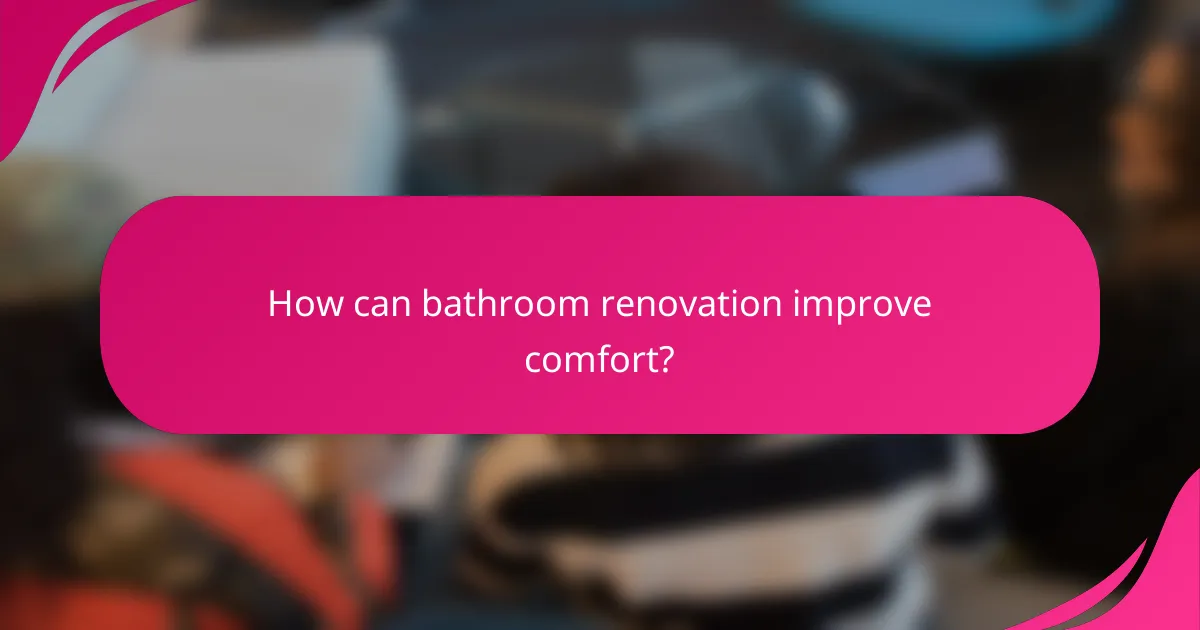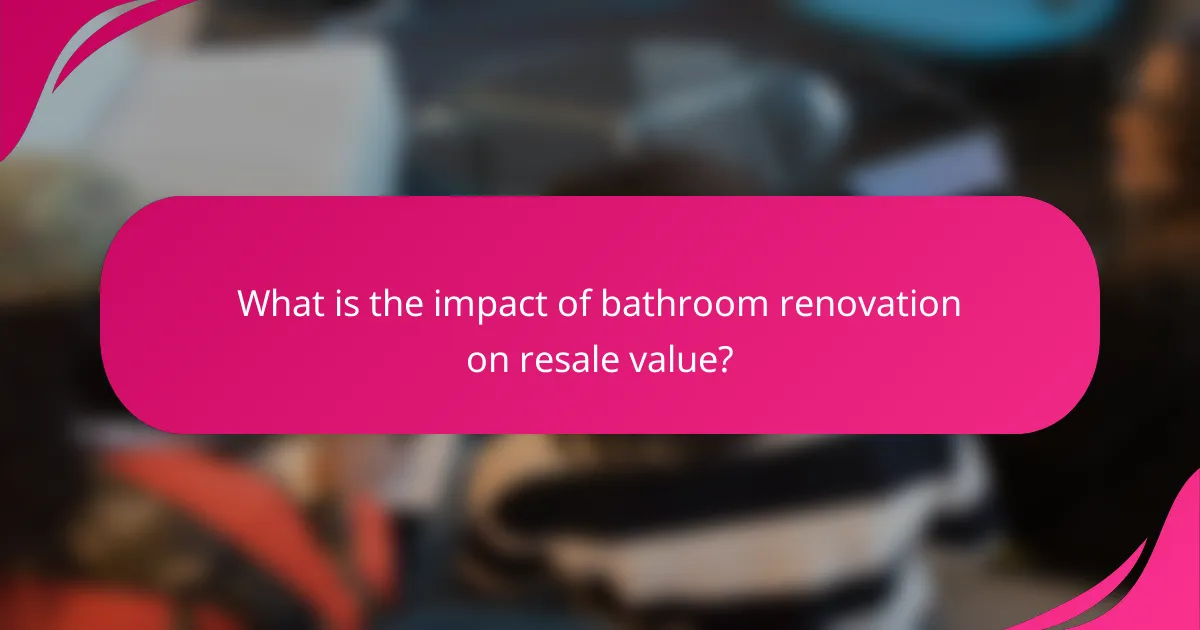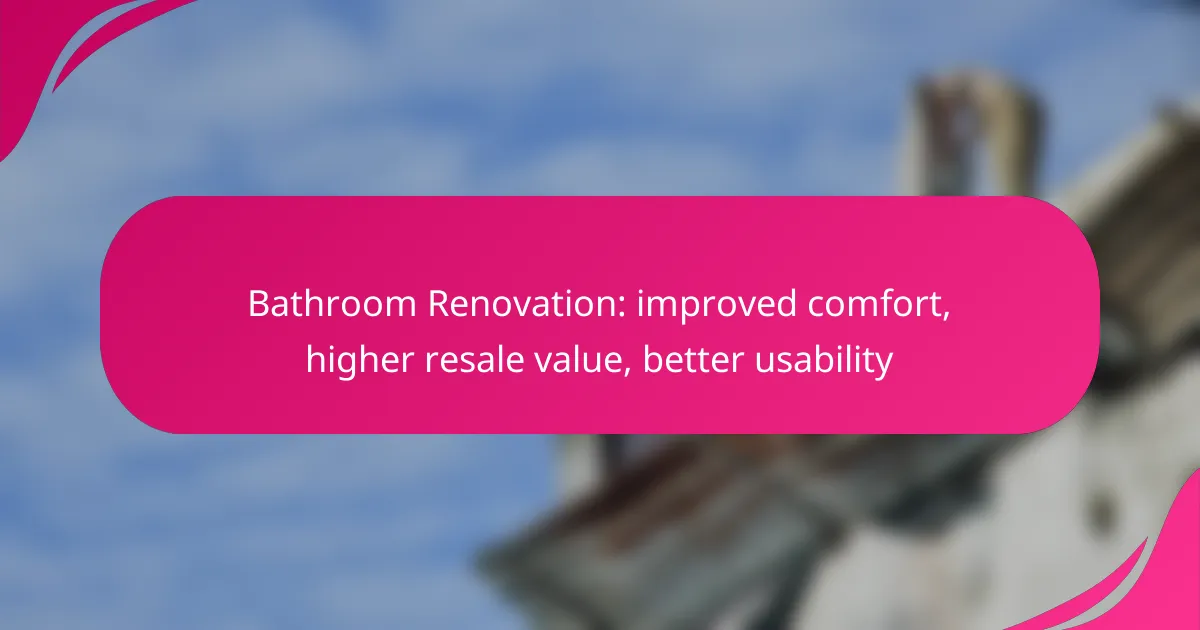Bathroom renovation is a powerful way to enhance comfort, usability, and the overall value of your home. By optimizing the layout, upgrading fixtures, and selecting durable materials, you can create a functional and inviting space that not only serves your daily needs but also appeals to potential buyers. Investing in a well-designed bathroom can yield a significant return on investment, making it a smart choice for homeowners looking to improve their living environment and increase resale value.

How can bathroom renovation improve comfort?
Bathroom renovation can significantly enhance comfort by creating a more functional and inviting space. By optimizing layout, upgrading fixtures, and improving lighting and ventilation, homeowners can transform their bathrooms into relaxing retreats.
Increased space and layout optimization
Renovating a bathroom often involves rethinking the layout to maximize available space. Consider removing unnecessary walls or fixtures to create a more open feel, which can make the room seem larger and more comfortable. For example, replacing a bulky tub with a sleek shower can free up valuable square footage.
When planning the layout, think about the flow of movement within the space. Ensure that essential elements like the toilet, sink, and shower are positioned for easy access. A well-optimized layout can enhance usability and comfort, making daily routines more efficient.
Upgraded fixtures and amenities
Replacing outdated fixtures with modern options can greatly improve comfort. Consider installing a high-efficiency toilet, a rainfall showerhead, or a heated towel rack. These upgrades not only enhance the user experience but can also lead to water savings and lower utility bills.
Additionally, incorporating amenities like a built-in bench or storage solutions can add convenience and comfort. Evaluate your needs and preferences to choose fixtures that align with your lifestyle, ensuring that your renovated bathroom meets your daily requirements.
Enhanced lighting and ventilation
Good lighting and ventilation are crucial for a comfortable bathroom environment. Natural light can make the space feel more inviting, so consider adding windows or skylights if possible. For artificial lighting, use a combination of ambient, task, and accent lighting to create a well-lit area that suits various activities.
Proper ventilation is equally important to prevent moisture buildup and mold growth. Installing an efficient exhaust fan can help maintain air quality and comfort. Aim for a fan that meets local building codes and is appropriately sized for your bathroom to ensure optimal performance.

What is the impact of bathroom renovation on resale value?
Bathroom renovation can significantly enhance a home’s resale value by improving aesthetics, functionality, and overall appeal. Homeowners often see a return on investment (ROI) that can range from moderate to high, depending on the extent of the upgrades and local market conditions.
High ROI on modern upgrades
Investing in modern upgrades for a bathroom typically yields a high ROI, often between 60% to 80%. Features such as energy-efficient fixtures, updated cabinetry, and stylish tile can attract buyers and justify a higher asking price.
When planning renovations, focus on improvements that are both functional and visually appealing. For example, replacing an old tub with a walk-in shower can enhance usability while appealing to contemporary tastes.
Market trends favoring renovated bathrooms
Current market trends indicate a strong preference for updated bathrooms, with many buyers prioritizing these spaces when house hunting. Homes with modern, well-designed bathrooms often sell faster than those with outdated facilities.
In many regions, buyers are willing to pay a premium for homes that feature luxurious amenities like double vanities, heated floors, and high-quality materials. Staying informed about local trends can guide your renovation choices to align with buyer expectations.
Appeal to potential buyers
A renovated bathroom can significantly enhance a home’s appeal to potential buyers by creating a sense of luxury and comfort. Clean lines, modern finishes, and effective use of space can make a lasting impression during showings.
Consider incorporating neutral colors and timeless designs to attract a broader range of buyers. Personal touches may be appealing, but they can also deter those with different tastes, so aim for a balance that showcases the bathroom’s potential.

What are the best materials for bathroom renovations?
Choosing the right materials for bathroom renovations is crucial for enhancing comfort, usability, and resale value. Prioritize durability, water resistance, and eco-friendliness to ensure a long-lasting and appealing space.
Durable flooring options
For bathroom flooring, consider materials like porcelain tile, vinyl, or natural stone. Porcelain tiles are particularly resilient and come in various styles, while luxury vinyl planks offer a softer feel underfoot and are often more affordable.
When selecting flooring, ensure it has a slip-resistant surface to enhance safety. A budget of around $5 to $15 per square foot is common for quality options, depending on the material and installation costs.
Water-resistant wall materials
Water-resistant wall materials are essential in bathrooms to prevent mold and damage. Options include ceramic tiles, fiberglass panels, and moisture-resistant drywall. Ceramic tiles are popular for their aesthetic appeal and durability.
When choosing wall materials, consider the ease of cleaning and maintenance. For instance, tiles may require grout sealing, while fiberglass panels can be wiped down easily. Budgeting around $3 to $10 per square foot for wall materials is typical.
Eco-friendly fixtures
Eco-friendly fixtures, such as low-flow toilets and faucets, can significantly reduce water consumption. Look for products with the WaterSense label, which indicates they meet efficiency standards without sacrificing performance.
Incorporating eco-friendly options not only benefits the environment but can also lower utility bills. Expect to invest a bit more upfront, typically 10-30% higher than standard fixtures, but the long-term savings can be substantial.

What are the costs associated with bathroom renovation?
The costs associated with bathroom renovation can vary widely based on the scope of the project, materials used, and labor costs. Homeowners typically spend anywhere from a few thousand to tens of thousands of dollars, depending on whether they are undertaking a minor update or a complete overhaul.
Average costs for mid-range renovations
For mid-range bathroom renovations, costs generally range from about $10,000 to $25,000. This budget typically covers new fixtures, cabinetry, flooring, and possibly some plumbing or electrical work. In urban areas or regions with higher labor costs, these figures may trend toward the upper end of the range.
Common upgrades in this price bracket include installing a new vanity, replacing the bathtub or shower, and updating tiles. Homeowners should expect to allocate a significant portion of their budget to labor, which can account for 20-35% of total costs.
Factors affecting renovation costs
Other factors include local labor rates, the need for structural changes, and any necessary permits. In some regions, specific regulations may require additional expenses for plumbing or electrical updates, which can further impact the budget.
Budgeting tips for homeowners
When budgeting for a bathroom renovation, it’s essential to set a realistic budget that includes a contingency of around 10-20% for unexpected expenses. Start by obtaining multiple quotes from contractors to ensure competitive pricing and to understand the market rates in your area.
Prioritize essential upgrades that improve functionality and comfort, such as better lighting or water-efficient fixtures, while considering aesthetic enhancements that can boost resale value. Avoid overspending on luxury items that may not yield a return on investment, especially in mid-range renovations.

How to choose a contractor for bathroom renovation?
Selecting the right contractor for your bathroom renovation is crucial for achieving your desired results. Focus on their experience, credentials, and customer feedback to ensure a successful project.
Evaluating contractor credentials
Begin by verifying the contractor’s licenses and insurance. A reputable contractor should have the necessary permits required by local regulations, which may vary by region.
Check for certifications from recognized industry organizations, as these indicate a commitment to quality and professionalism. For example, certifications from the National Association of Home Builders (NAHB) can be a good sign.
Importance of reviews and referrals
Reviews and referrals are essential in assessing a contractor’s reliability and quality of work. Look for testimonials on their website, social media, and independent review platforms.
Ask friends or family for recommendations based on their experiences. A contractor with a strong track record and positive feedback is more likely to deliver satisfactory results.
Questions to ask during consultations
Prepare a list of questions to ask potential contractors during consultations. Inquire about their experience with similar projects, timelines, and payment structures.
Additionally, ask about their approach to handling unexpected issues that may arise during the renovation. Understanding their problem-solving strategies can give you confidence in their capabilities.

What are common mistakes in bathroom renovations?
Common mistakes in bathroom renovations often stem from poor planning, lack of attention to essential systems, and overlooking usability. These errors can lead to increased costs, reduced comfort, and lower resale value.
Ignoring plumbing and electrical needs
Ignoring plumbing and electrical needs can result in significant issues during and after a renovation. Properly assessing the existing systems is crucial to avoid costly repairs later. For instance, if you plan to move fixtures, ensure that plumbing lines can accommodate the new layout.
When renovating, consider the local building codes that govern plumbing and electrical work. These regulations are designed to ensure safety and functionality, so it’s wise to consult a professional if you’re unsure about compliance.
To avoid pitfalls, create a checklist of plumbing and electrical requirements before starting the renovation. This should include verifying the condition of pipes and wiring, ensuring adequate ventilation, and planning for any necessary upgrades. Addressing these needs upfront can save time and money in the long run.
